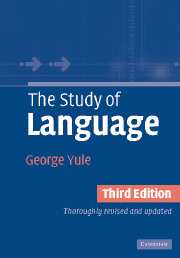Book contents
- Frontmatter
- Contents
- Preface
- The origins of language
- Animals and human language
- The development of writing
- The sounds of language
- The sound patterns of language
- Words and word-formation processes
- Morphology
- Phrases and sentences : grammar
- Syntax
- Semantics
- Pragmatics
- Discourse analysis
- Language and the brain
- First language acquisition
- Second language acquisition/learning
- Gestures and sign languages
- Language history and change
- Language and regional variation
- Language and social variation
- Language and culture
- Appendix: Suggested answers to study questions
- Glossary
- References
- Index
The sound patterns of language
- Frontmatter
- Contents
- Preface
- The origins of language
- Animals and human language
- The development of writing
- The sounds of language
- The sound patterns of language
- Words and word-formation processes
- Morphology
- Phrases and sentences : grammar
- Syntax
- Semantics
- Pragmatics
- Discourse analysis
- Language and the brain
- First language acquisition
- Second language acquisition/learning
- Gestures and sign languages
- Language history and change
- Language and regional variation
- Language and social variation
- Language and culture
- Appendix: Suggested answers to study questions
- Glossary
- References
- Index
Summary
Uans appona taim uas tri berres; mamma berre, pappa berre, e beibi berre. Live inne contri nire foresta. NAISE AUS. No mugheggia. Uanna dei pappa, mamma, e beibi go bice, orie e furghetta locche di dorra.
Bai ene bai commese Goldilocchese. Sci garra natingha tu du batte meiche troble. Sci puscia olle fudde daon di maute; no live cromma. Den sci gos appesterrese enne slipse in olle beddse.
Bob Belviso, quoted in Espy (1975)In the preceding chapter, we investigated the physical production of speech sounds in terms of the articulatory mechanisms of the human vocal tract. That investigation was possible because of some rather amazing facts about the nature of language. When we considered the human vocal tract, we didn't have to specify whether we were talking about a fairly large person, over six feet tall, weighing over 200 pounds, or about a rather small person, about five feet tall, weighing less than 100 pounds. Yet those two physically different individuals would inevitably have physically different vocal tracts, in terms of size and shape. In a sense, every individual has a physically different vocal tract. Consequently, in purely physical terms, every individual will pronounce sounds differently. There are, then, potentially millions of physically different ways of saying the simple word me.
Information
- Type
- Chapter
- Information
- The Study of Language , pp. 43 - 51Publisher: Cambridge University PressPrint publication year: 2005
